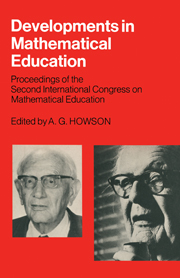 Developments in Mathematical Education
Developments in Mathematical Education Book contents
- Frontmatter
- Contents
- Editor's Acknowledgements
- PART I A CONGRESS SURVEY
- PART II THE INVITED PAPERS
- PART III A SELECTION OF CONGRESS PAPERS
- Investigation and problem-solving in mathematical education
- Intuition, structure and heuristic methods in the teaching of mathematics
- Mathematics and science in the secondary school
- Geometry as a gateway to mathematics
- The International Baccalaureate
- The role of axioms in contemporary mathematics and in mathematical education
- Implications of the work of Piaget in the training of students to teach primary mathematics
- Are we off the track in teaching mathematical concepts?
- Appendices
- Index
Geometry as a gateway to mathematics
from PART III - A SELECTION OF CONGRESS PAPERS
- Frontmatter
- Contents
- Editor's Acknowledgements
- PART I A CONGRESS SURVEY
- PART II THE INVITED PAPERS
- PART III A SELECTION OF CONGRESS PAPERS
- Investigation and problem-solving in mathematical education
- Intuition, structure and heuristic methods in the teaching of mathematics
- Mathematics and science in the secondary school
- Geometry as a gateway to mathematics
- The International Baccalaureate
- The role of axioms in contemporary mathematics and in mathematical education
- Implications of the work of Piaget in the training of students to teach primary mathematics
- Are we off the track in teaching mathematical concepts?
- Appendices
- Index
Summary
Introduction
The role of geometry in the study of mathematics has been a special interest of mine for several years. During the past year I have enjoyed a sabbatical from my university teaching and made a special effort to discover what is happening to the role of geometry. I have found two papers particularly enlightening and would like to quote from them as background for our considerations of geometry as a gateway to mathematics. I believe that geometry serves this role at all levels – in elementary schools, in secondary schools, and in colleges and universities.
Professor E. Spanier wrote in 1970, in an article entitled ‘The Undergraduate Program in Mathematics’, that:
Broadly speaking, the goal of undergraduate mathematics education should be to help the student to understand something about mathematics both in its internal structure and in its relations with other disciplines. He should get a feeling of the vitality of the subject and enough history to appreciate current trends and progress. He should have studied some areas of mathematics, possibly only small parts, in depth, but he should also obtain some sort of global view of mathematics by the time he graduates. These objectives are important for all mathematics majors.
- Type
- Chapter
- Information
- Developments in Mathematical EducationProceedings of the Second International Congress on Mathematical Education, pp. 241 - 253Publisher: Cambridge University PressPrint publication year: 1973
- 2
- Cited by


